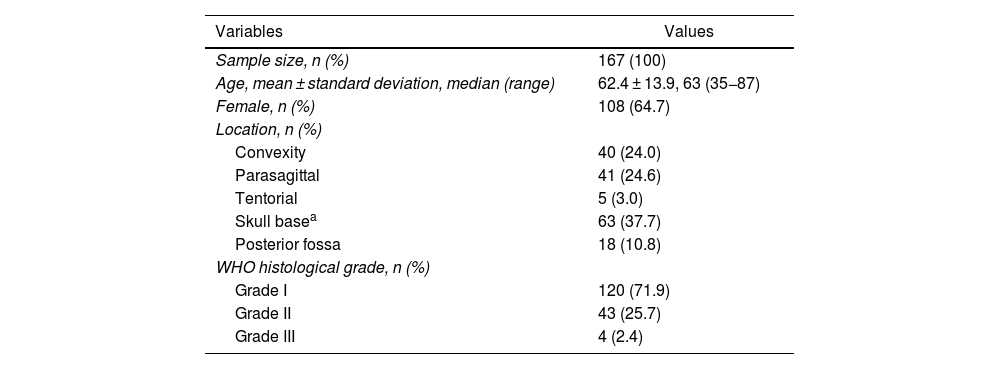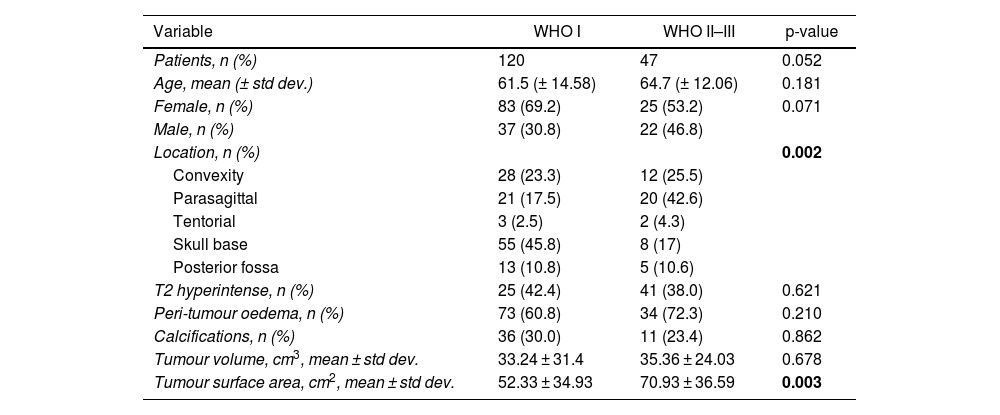Predicting the histopathologic grade of meningioma is relevant because local recurrence is significantly greater in WHO grade II–III compared to WHO grade I tumours, which would ideally benefit from a more aggressive surgical strategy. It has been suggested that higher WHO grade tumours are more irregularly-shaped. However, irregularity is a subjective and observer-dependent feature. In this study, the tumour surface irregularity of a large series of meningiomas, measured upon preoperative MRI, is quantified and correlated with the WHO grade.
MethodsUnicentric retrospective observational study of a cohort of symptomatic meningiomas surgically removed in the time period between January 2015 and December 2022. Using specific segmentation software, the Surface Factor (SF) was calculated for each meningioma. SF is an objective parameter that compares the surface of a sphere (minimum surface area for a given volume) with the same volume of the tumour against the actual surface of the tumour. This ratio varies from 0 to 1, being 1 the maximum sphericity. Since irregularly-shaped meningiomas present proportionally greater surface area, the SF tends to decrease as irregularity increases. SF was correlated with WHO grade and its predictive power was estimated with ROC curve analysis.
ResultsA total of 176 patients (64.7% females) were included in the study; 120 WHO grade I (71.9%), 43 WHO grade II (25.7%) and 4 WHO grade III (2.4%). A statistically significant difference was found between the mean SF of WHO grade I and WHO grade II–III tumours (0.8651 ± 0.049 versus 0.7081 ± 0.105, p < 0.0001). Globally, the SF correctly classified more than 90% of cases (area under ROC curve 0.940) with 93.3% sensibility and 80.9% specificity. A cutoff value of 0.79 yielded the maximum precision, with positive and negative predictive powers of 82.6% and 92.6%, respectively. Multivariate analysis yielded SF as an independent prognostic factor of WHO grade.
ConclusionThe Surface Factor is an objective and quantitative parameter that helps to identify aggressive meningiomas preoperatively. A cutoff value of 0.79 allowed differentiation between WHO grade I and WHO grade II–III with high precision.
Predecir el grado histológico de los meningiomas es importante por cuanto los grados OMS II-III presentan mucha mayor tendencia a la recidiva local que los grado OMS I y, por tanto, pueden beneficiarse de una estrategia quirúrgica más agresiva. Se ha sugerido que los meningiomas con forma más irregular en la RM preoperatoria tienden a ser más agresivos. Sin embargo, dicha irregularidad es un concepto subjetivo y observador-dependiente. En este estudio se cuantifica de forma objetiva la irregularidad de una serie de meningiomas y se correlaciona con el grado histológico de la OMS.
MétodosEstudio observacional retrospectivo unicéntrico de una cohorte de meningiomas sintomáticos intervenidos en el período entre enero 2015 y diciembre 2022. Mediante software de segmentación, para cada meningioma se calculó el denominado Factor de Superficie (FS) que es un parámetro objetivo que relaciona la superficie de una esfera (figura con la menor área para un volumen dado) de igual volumen que el tumor con la superficie real del tumor. Este cociente varía de 0 a 1, siendo 1 la máxima esfericidad posible. Dado que los meningiomas de forma irregular presentan una mayor superficie en relación a su volumen, su FS tiende a ser menor cuanto más irregular es el tumor. Se correlacionaron los FS con el grado histológico y se evaluó el poder predictivo del FS mediante curva ROC.
ResultadosSe incluyeron un total de 176 pacientes (64,7% mujeres); 120 grado OMS I (71,9%), 43 grado OMS II (25,7%) y 4 grado OMS III (2,4%). Se constató una diferencia significativa en el FS entre los meningiomas grado OMS I y los OMS II-III (0,8651 ± 0,049 versus 0,7081 ± 0,105, p < 0,0001). Globalmente, el FS permitió clasificar correctamente más del 90% de los pacientes (área bajo la curva ROC de 0,940), con una sensibilidad y especificidad del 93,3% y 80,9%, respectivamente. Un valor de corte de 0,79 proporcionó la máxima precisión para clasificar correctamente el grado histológico, con valores predictivos positivo y negativo del 82,6% y 92,6%, respectivamente. El análisis multivariante identificó el FS como factor pronóstico independiente del grado histológico.
ConclusiónEl Factor de Superficie es un parámetro cuantitativo y objetivo que ayuda a identificar los meningiomas agresivos de forma preoperatoria. Un valor de corte de 0,79 permite diferenciar los meningiomas OMS I de los OMS II-III con alta precisión.
Article

If it is the first time you have accessed you can obtain your credentials by contacting Elsevier Spain in suscripciones@elsevier.com or by calling our Customer Service at902 88 87 40 if you are calling from Spain or at +34 932 418 800 (from 9 to 18h., GMT + 1) if you are calling outside of Spain.
If you already have your login data, please click here .
If you have forgotten your password you can you can recover it by clicking here and selecting the option ¿I have forgotten my password¿.















